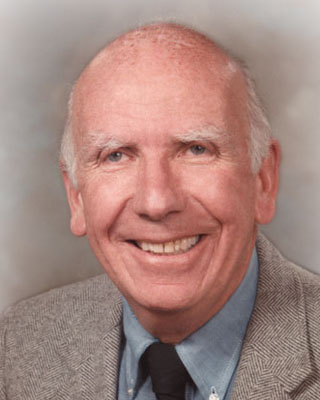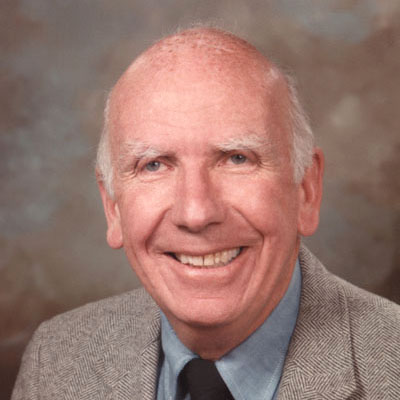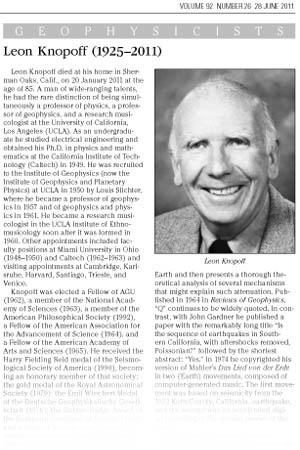By Paul Davis and David Jackson, UCLA,
and Freeman Gilbert, UCSD
Leon Knopoff died at his home in Sherman Oaks, Calif., on January 20, 2011 at the age of 85. A man of wide-ranging talents, he had the rare distinction of being simultaneously a professor of physics, a professor of geophysics, and a research musicologist at the University of California, Los Angeles (UCLA). As an undergraduate he studied electrical engineering and obtained his PhD in physics and mathematics at the California Institute of Technology (Caltech) in 1949. He was recruited to the Institute of Geophysics (now the Institute of Geophysics and Planetary Physics) at UCLA in 1950 by Louis Slichter, where he became a professor of geophysics in 1957 and of geophysics and physics in 1961. He became a research musicologist in the UCLA Institute of Ethnomusicology soon after it was formed in 1960. Other appointments included faculty positions at Miami University in Ohio (1948-1950) and Caltech (1962-1963) and visiting appointments at Cambridge, Karlsruhe, Harvard, Santiago, Trieste, and Venice.
Knopoff was elected a Fellow of AGU (1962), a member of the National Academy of Sciences (1963), a member of the American Philosophical Society (1992), a Fellow of the American Association for the Advancement of Science (1964), and a Fellow of the American Academy of Arts and Sciences (1965). He received the Harry Fielding Reid medal of the Seismological Society of America (1990), becoming an honorary member of that society; the gold medal of the Royal Astronomical Society (1979); the Emil Wiechert Medal of the Deutsche Geophysikalische Gesellschaft (1978); the Golden Badge Award of the European Geophysical Society (2001); and a docteur honoris causa from Université Louis-Pasteur, Strasbourg, France (2004). He was elected Fellow of Selwyn College, Cambridge (1986). He visited China in the 1970s, returning often to collaborate. He was named the first honorary professor of the Institute of Geophysics of the China Earthquake Administration (2004).
Knopoff served as the director of the Institute of Geophysics and Planetary Physics (IGPP) at UCLA for 14 years. He was a founding member and secretary general of the International Upper Mantle Project; founder and chairman of the International Union of Geodesy and Geophysics Committee on Mathematical Geophysics; chair of the US Upper Mantle Committee; chair of the US Committee for the International Association of Seismology and Physics of the Earth's Interior; and chair of the Ad Hoc Committee on Seismology and Aftershocks, Atomic Energy Commission. He served as editor of Nonlinear Processes in Geophysics and associate editor of Reviews of Geophysics and Space Physics and Journal of Geophysical Research-Solid Earth. Of his 366 publications, 61 were in AGU journals.
His selfless cooperation was truly global, but nowhere was it better demonstrated than at his home institution in his dedicated teaching of undergraduate students, 39 PhD students, 40 postdocs, and colleagues from more than 17 countries. Leon Knopoff was an inspiring teacher who excelled at simplifying complex topics and encouraging learning. It is not surprising that he won the outstanding teacher award in the UCLA physics department four times, which for him was a source of great pride.
He began his career with a series of laboratory experiments that compared seismic theory with observations. His laboratory skills led to his codiscovery with George Kennedy of thermoluminescence dating. In 1956 his work took a theoretical turn, resulting in a famous paper that led to the representation theorem for calculating ground motions arising from body forces and motions on a surface such as an earthquake fault. In that paper, Knopoff extended to the elastodynamic problem Kirchhoff's retarded potential solution to the wave equation, thereby providing the elastic analog to Green's theorem.
 L E O N K N O P O F F ____________________________________________________________________________________________________________
L E O N K N O P O F F ____________________________________________________________________________________________________________

